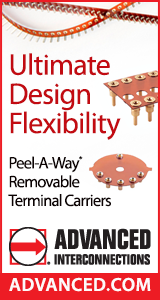|

|
|
| Ask the Experts | |||||||
|
|||||||
|
September 12, 2025 - Updated January 25, 2018 - Originally Posted Allowable Bow and Twist on Round PC FabOn my PCB fab drawing I specified - Overall board bow and twist should not exceed 0.005 in/in as per the latest revision of IPC-A-600 standard. I would like to know how you interpret it? If my fab is round, 11 inches in diameter, what is the allowable bow and twist? B.D. |
|||||||
| Expert Panel Responses | |||||||
|
B.D. great question I hope I have a good answer. Both the IPC-A-600 and IPC-6012 documents state the bow and twist of a board shall be .75% or less for SMT and 1.5% for all others unless specified on procurement documentation. For pallet arrays it shall be AABUS. The documents do not get specific on the shape of the board but rather the thickness. However, the IPC-TM-650 Method 2.4.22 states that "Measurements on nonrectangular samples pose a unique testing problem and may necessitate careful evaluation of the requirement imposed by the users of this test method". Also, in paragraph 3.1 of this test method gives direction as to the most "convenient" way to test and other than rectangle board. So my take is AABUS is the bottom line . As example if I have a diameter vs. length I would work with the radius . In this case 11 "would be 5.5". Now if I were to look at center out on flat surface and apply 1.5% in 360 degree radius unless AABUS states otherwise ?
Fellow Raytheon Mark has over 35 years of experience in electronics fabrication, quality, and reliability while working for Raytheon RMD, IEC Electronics, GE, Motorola, ORS, etc. He has most recently taken the role as a Fellow at Raytheon in Tucson, AZ; prior to that, he established IEC Electronics Analysis and Testing Laboratories (IATL), LLC in Albuquerque, NM, for electronics and material analysis testing in the military, medical, and industrial industries. His expertise includes PCB, PCBA, components, and analytical and electrical analysis techniques.
The geometric tolerances specified in the IPC-A-600 standard should apply even if the board is routed in the shape of a disk. The specification shouldn't really change since the bow and twist are specified in an amount per inch. They can be measured on a disk as well as on a rectangle. If your board supplier tells you the act of routing the PCB to form a disk will alter it dimensionally, then you need to discuss this with them. Since the board is round it will most likely need to be fixtured during soldering. If your board is mixed-technology or contains through-hole connectors or components it will most likely be either wave or selectively soldered. With either soldering process most boards have a tendency to warp, or sag, in relation to the bottom plane of the board when the glass transition temperature is exceeded combined with the weight of the SMT and through-hole components. In wave soldering this is often overcome by fixturing which requires NRE costs for both tooling and secondary labor operations. With selective soldering this can be overcome by using a selective soldering machine equipped with a board warp compensation function that measures the negative Z-axis value (or downward board sag) and automatically corrects the Z-axis heights for the solder nozzle. When choosing a selective soldering system it is important to select a system that can detect board warpage without erroneous feedback from either tooling holes, slots or score marks in the board or reflectivity from the solder mask.
General Manager Nordson SELECT Carlos Bouras is the General Manager of Nordson SELECT and has over 30 years of experience in the electronics manufacturing industry. Carlos's expertise is in process engineering, product development and manufacturing operations. For the past 15 years Carlos has focused specifically on automated assembly issues and is the holder of several US patents for non-contact dispensing and precision dispensing of adhesives for the packaging of microprocessor devices.
My approach would be as follows:
Process Engineer Astronautics Fritz's career in electronics manufacturing has included diverse engineering roles including PWB fabrication, thick film print & fire, SMT and wave/selective solder process engineering, and electronics materials development and marketing. Fritz's educational background is in mechanical engineering with an emphasis on materials science. Design of Experiments (DoE) techniques have been an area of independent study. Fritz has published over a dozen papers at various industry conferences.
Reader Comment
I assumed the question posted by B.D was 7 years ago and is revisited on 12 Sep 2025. B.D mentioned that the value of B&T is 0.005in/in in the lasted revision of IPC-A-600. However, I cannot find this value in IPC-A-600M or IPC-6012F. Did I miss something and how this 0.005in/in come about or calculated?
lum wee mei, ST Engineering Satellite Systems Pte Ltd
|
|||||||
| Submit A Comment | |||||||
|
Comments are reviewed prior to posting. You must include your full name to have your comments posted. We will not post your email address. |
|
Free Newsletter Subscription
Circuitnet is built for professionals who bear the responsibility of looking ahead, imagining the future, and preparing for it. Insert Your Email Address |
|

|





